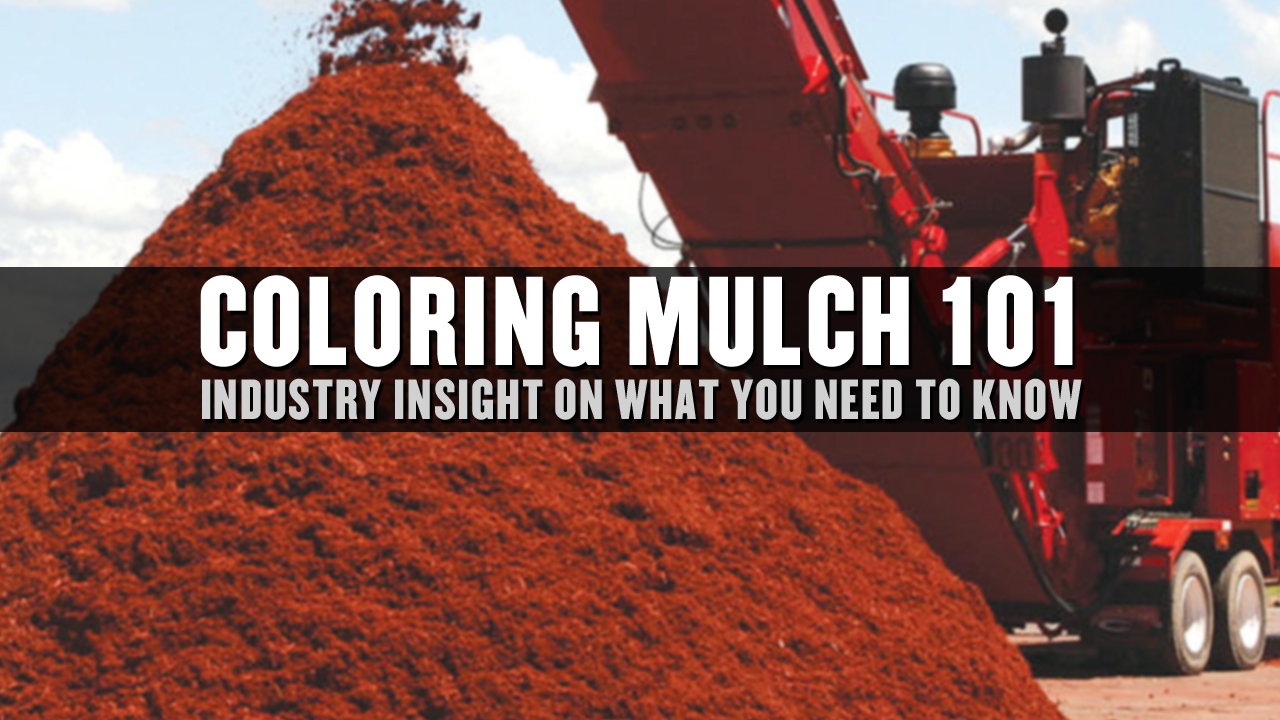
Almost every mulch producer has considered coloring their mulch in hopes of maximizing profits or to find an additional outlet for their finished product. It seems like an easy process; add colorant and out comes mulch every color of the rainbow. To be honest, coloring mulch is not difficult; however, there are some details that you may not have considered.
Do you know that you need approximately 8-18 gallons of water to make one yard of mulch?
If you want to process 100 yards per hour, you will need roughly 800-1,800 gallons per hour. The amount of moisture in your wood will determine the amount of water you need, but having a reliable, clean water source is extremely important as relying on public water can be extremely expensive.
Do you know colorants come in three different forms?
Most consumers are familiar with liquid colorant, but colorant also comes in powder and in granular forms. You must know which is best for your coloring needs.
- Powder Colorant: This is normally used for coloring concrete, stucco, etc. The only time powder is used to color mulch is when bulk powder colorant is manually poured on a finished mulch pile and mixed manually. This is very labor intensive and messy. It is however the least expensive way to color mulch and no colorizing equipment is needed. The finished product may not be as consistent with this process.
- Granular Colorant: Granular colorant is different from Powder as it is pelletized and flows easily. This granular colorant is dispensed dry either into a wood grinder or trommel screen and water is added by means of spray bars. The advantage of this system is that you are paying freight for only the pigment and not water.
- Liquid Colorant: Liquid colorant comes in a concentrate and is diluted with water by means of Colorizer Equipment and then dispersed via spray bars on a wood grinder or trommel screen, or is added to a tub style colorizer equipped with screw/pugmill paddles in the tub. This is the most popular colorant form.
Do you know how much colorant costs per one yard of mulch?
This is the most popular question we get asked and the answer is somewhat complex as it depends on a variety of variables:
- Color of wood needing colored: We all know the lighter the wood the easier it is to color. For mulch colors like yellow, red, blue, green, etc. the raw material needs to be a blonde/very light colored wood, dimensional lumber, or ground pallets. For coloring black or brown mulch, you can use a darker wood. You can use ground yard waste for darker mulches, but remember the fines suck up colorant so removing 75% of them is a great idea.
- Coloring equipment: When using a grinder or tub style colorizer, our customers use 4-5 pounds of colorant per yard but when using a trommel type colorizer, they use only 3-4 pounds of colorant per yard.
- Quality of Color/Pigment you buy: You can buy colorant for as cheap as 65¢ per pound for pure junk, 80¢ to 90¢ for good quality, and as much as $1.20 per pound for premium colorant. The difference for coloring between the different qualities is the amount of color needed and how quick the mulch color will look chalky. For junky colorant, one needs approximately 5 to 6 pounds to color per yard (trommel) and for good quality colorant, 3 to 4 pounds of colorant per yard (trommel). For premium colorant, 2-3 pounds per yard (trommel)
Let’s do the math:
Wood Grinder or bath type tub colorizer:
- Junky colorant: 65¢ x 6.5 = $4.23 / yard
- Good colorant: 85¢ x 4.5 = $3.83 / yard
- Premium colorant: $1.20 x 2.75 = $3.30 / yard
Trommel Style Colorizer:
- Junky colorant: 65¢ x 5.5 = $3.58 / yard
- Good Colorant: 85¢ x 3.5 = $2.98 / yard
- Premium Colorant: $1.20 x 2.50 = $3.00 / yard
- Location to mulch coloring pigments: Freight also makes a difference to the cost of coloring.
In summation, the most economical way to color, if you are just looking at cost of colorant, is to use a trommel style colorizer and use top of the line colorant.
I know the majority of my customers will want to disagree; however, these are our findings. There are many other factors that must be considered as well to determine the actual cost of your colored mulch. As discussed, you need water, and the trommel style colorizer uses less water than the alternatives. The one factor that has not been addressed is that most colorizing customers own a grinder, so to make the savings per yard, they must purchase a trommel style colorizer. Many old trommels can be easily converted so this is a great option. If you do not own a trommel then you must weigh out the options. Lastly, there is a cost to move mulch within your yard so a dollar value must be placed on this as well. Regardless, buying cheap colorant is not the answer as it will cost you more money in the long run and it will not last long, making for an unhappy market place.
You can see our current selection of New & Used Colorizers on our Mulch Colorizers page.
See our other guides like, "How do Make my Mulch More Consistant?" or "How do I keep my Red Mulch from Turning Maroon?"
If you need Equipment o make mulch, see our selection of Horizontal Grinders & Tub Grinders
